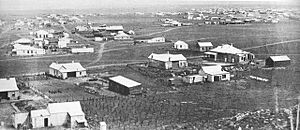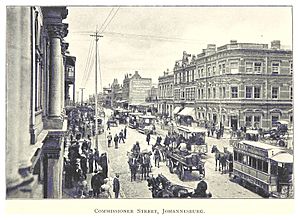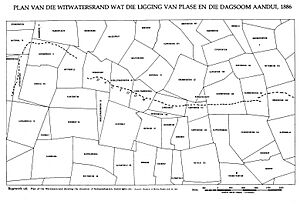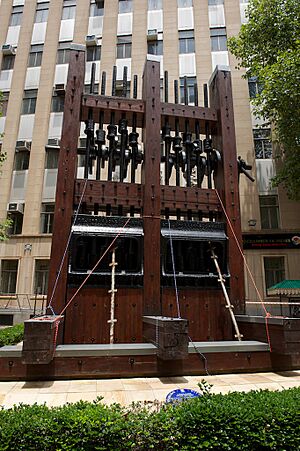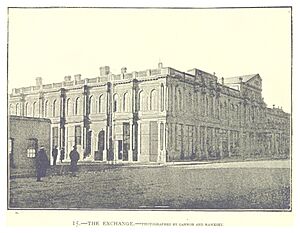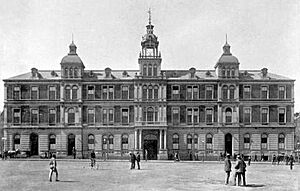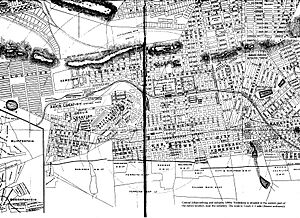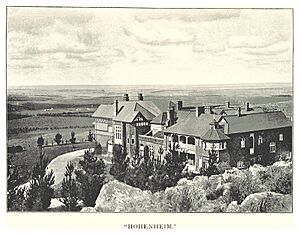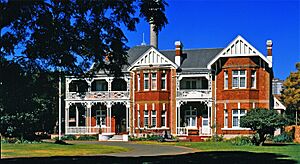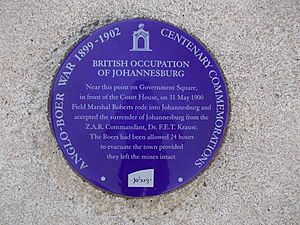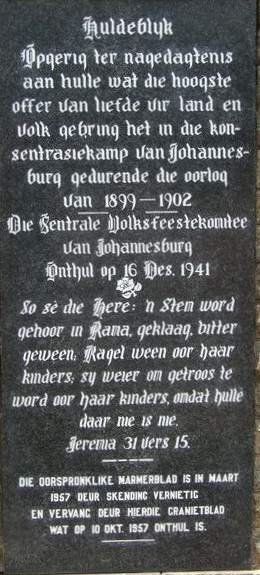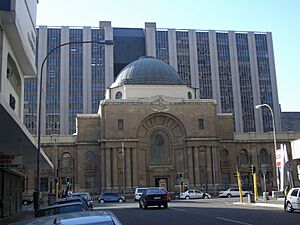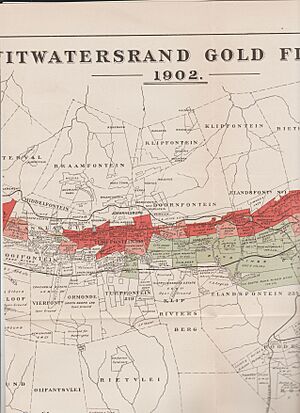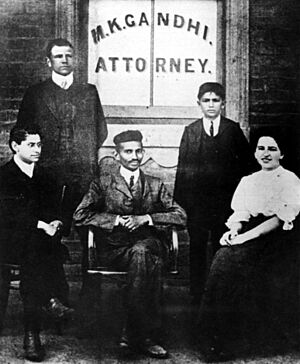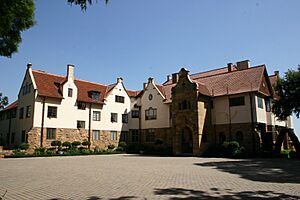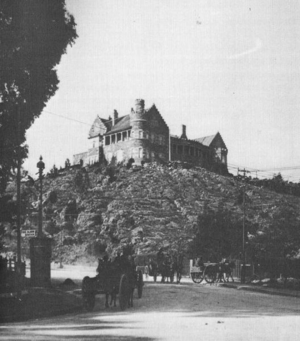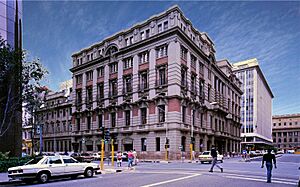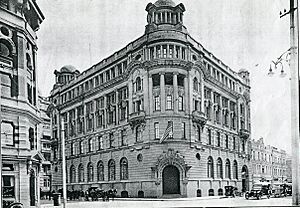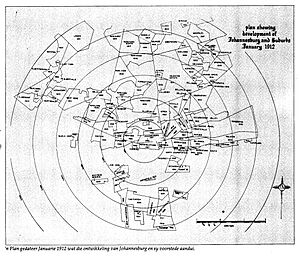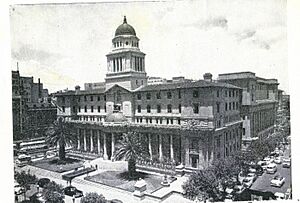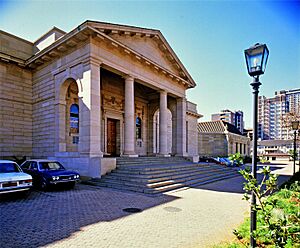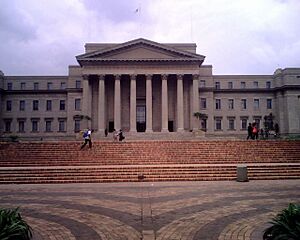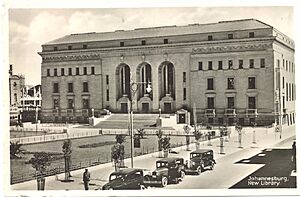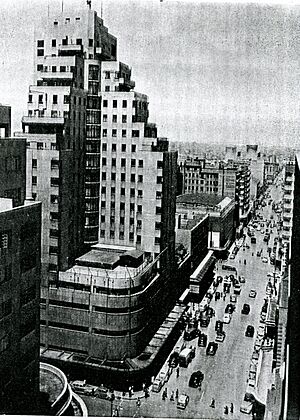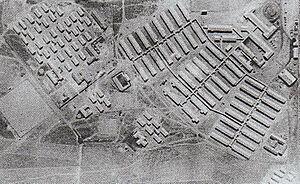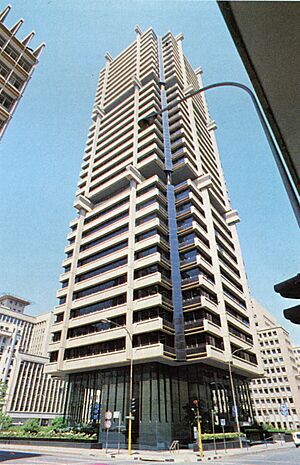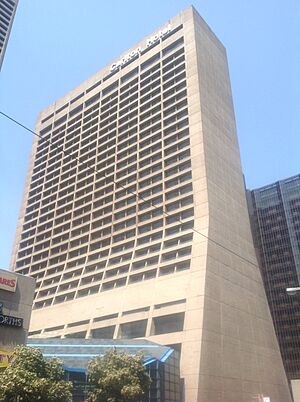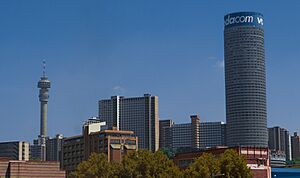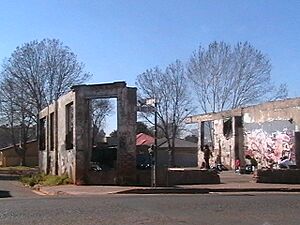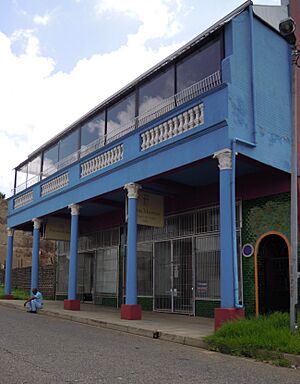History of Johannesburg facts for kids
Johannesburg is a very large city in the Gauteng Province of South Africa. It started as a small village in 1886. This happened after gold was discovered on a farm called Langlaagte. The city grew very quickly. It became a municipality (a town with its own local government) in 1898. In 1928, Johannesburg officially became a city. Today, it is the biggest city in South Africa. It is also a major center for learning and fun for everyone in the country. Johannesburg is the capital city of Gauteng province.
Contents
Ancient Times in Johannesburg
The area around Johannesburg was first home to hunter-gatherers. These early people used tools made of stone. By the 6th century, farmers settled in the Magaliesberg valley, north of Johannesburg. This valley was perfect for farming.
By the 13th century, people built stone-walled towns and villages. These belonged to the Sotho–Tswana people. Many of these sites show old mines and iron-making furnaces. This suggests that people used the area's minerals long before Europeans arrived. One important site in Johannesburg is Melville Koppies. It still has an old iron smelting furnace.
The Republic Era
European Settlers and Gold Mining
After a big journey called the Great Trek, European farmers also settled in the Transvaal. Some chose to farm where Johannesburg would later be built. Each citizen, called a burgher, received a large farm.
The first gold discovery in the Witwatersrand area was in June 1884. It was found by Jan Gerrit Bantjes. George Harrison is now known for finding the main gold reef in February 1886. This happened on the Langlaagte farm. Soon, more gold was found on other farms like Turffontein and Doornfontein.
On September 8, 1886, nine farms were declared public digging areas. This meant anyone could dig for gold there. Carl von Brandis was put in charge of mining for the area.
At first, miners could dig for gold themselves. They used simple tools. But as the mines got deeper, they needed more workers and machines. African people were hired for the hard work. Machines came from Europe. Fuel was needed to power them.
The discovery of coal nearby helped the gold industry grow. Railways were also built from the coast. This made it easier to bring in supplies. By 1890, a new process helped get more gold from deeper levels.
Soon, individual miners couldn't dig enough gold. Deep mining needed big companies with lots of money and skills. Smaller mining groups joined together. By 1895, a few large companies controlled most of the gold mining.
In 1893, Johannesburg's first stock exchange opened. Since then, Johannesburg has been South Africa's financial center. The Johannesburg Stock Exchange is now in Sandton.
The Zuid-Afrikaansche Republic became the world's biggest gold producer. In 1898, it produced over a quarter of the world's gold.
How Johannesburg Became a City
The new town of Johannesburg was built on government land. This land was called Randjeslaagte. The first sale of land plots happened on December 8, 1886. The town was named after two officials, Christiaan Johannes Joubert and Johannes Rissik. They both worked in land surveying. They combined their shared name, Johannes, with 'burg'. 'Burg' is an old Afrikaans word for 'fortified city'.
In early 1887, people asked the government for a town council. In November 1887, a health committee was set up instead. It covered Johannesburg and nearby areas. This committee helped manage the growing settlement. In 1897, the government finally approved a town council for Johannesburg. Johan Zulch de Villiers became the first mayor of Johannesburg in October 1897.
The Rissik Street Post Office was built in 1897. It was once the tallest building in Johannesburg. It became a national monument in 1978. The Post Office stopped operating in 1996. A fire damaged the building in 2009.
The Gold Rush Boom
Within ten years of gold discovery, 100,000 people rushed to Johannesburg. They came from all over the world to find riches. People from other parts of South Africa, India, China, Europe, and America arrived. Miners, artisans, businessmen, and engineers all came seeking new opportunities.
In January 1890, the town had 26,303 people. There were many buildings, including shops, stores, hotels, and bars. Several suburbs were recorded, like Booysens and Jeppe's Town. There were also informal settlements.
By January 1896, Johannesburg's population grew to 102,078. This included Europeans, Asians, and African people. Many new suburbs had been added. Kliptown is the oldest Black residential area in Johannesburg. It was first laid out in 1891.
Society and Living Areas
From the start, Johannesburg was divided by wealth and, to some extent, by race. Some areas were for working-class families. Factories and businesses grew in these areas.
Doornfontein was a 'classy' suburb. Professional and business people lived there. Many Jewish families also lived there. The first English school in Johannesburg was started by the Holy Family Sisters in 1887.
To the west, Braamfontein was home to white workers and single men.
The government bought land in Braamfontein. They planned to sell water to residents. But they also found a lot of clay for brickmaking. Many poor Dutch-speaking citizens settled there and made bricks. This area became known as Brickfields. Soon, other working-class people, including Malays, Indians, and Africans, also settled there. The area remained mixed-race.
On February 19, 1896, a huge dynamite explosion happened in Braamfontein. It left a large crater. At least 78 people died, and 1500 were injured. This led to efforts to separate different groups of people into new suburbs.
Living conditions on the mines were tough. African workers lived in crowded, cold bunk houses. Food was scarce, and lung diseases were common. White miners lived better, but not always in great comfort.
Meanwhile, Parktown, in the north, became known for its wealth. Rich mining leaders, called Randlords, built large mansions there. "Hohenheim" was built in 1894. "The View" was completed in 1897. These grand homes showed the city's growing wealth.
Voting Rights and Conflict
The law stated that white men who lived in the Transvaal for five years could vote. As more foreigners, called Uitlanders, arrived for gold, the government worried they would take control. So, they created a Second Volksraad (assembly). Uitlanders could vote for this second assembly, but it had limited power. The main Volksraad still made the important laws.
Uitlanders were unhappy. They complained about unfair officials and high prices for goods. The government's system of special permits also caused problems. The government was not set up to manage a fast-growing industrial state.
A Reform Committee was formed in Johannesburg. Cecil John Rhodes, the prime minister of the Cape Colony, supported an invasion. This was the Jameson Raid, but it failed. Rhodes had to resign.
Later, the British Colonial Secretary, Joseph Chamberlain, supported the Uitlanders' right to vote. He appointed Alfred Milner as British Commissioner. No agreement was reached. On October 11, 1899, war broke out between Great Britain and the Zuid-Afrikaansche Republiek. This was the Second Boer War.
Second Boer War
Before May 31, 1900
People Leaving Johannesburg
By May 1899, war seemed likely. Many people started to leave Johannesburg. First, families of wealthy people left. Then, white miners joined them. By mid-October, almost 100,000 white people had left the area. Only about 10,000 white people remained in the city when the war began.
Transporting so many people was a huge task. At first, only third-class passengers traveled in open coal trucks. Soon, even first-class passengers were happy to travel in these trucks to reach the coast.
John Sidney Marwick helped thousands of Zulu men working in the mines. Many were stuck in Johannesburg. Marwick got permission for them to walk back to Natal. This long march started on October 6, 1899. They faced heavy rain and harsh conditions. They eventually reached safety in Natal.
Mines Closing Down
On September 4, 1899, the government realized mines would be important for war money. They wanted to keep them open. A law was brought back that allowed the government to take over mines if they stopped working during martial law. Any gold found would help pay for the war.
Many well-known mines closed by the end of September. By October 7, 66 major mines had closed. Some mines offered bonuses to white workers who stayed. Some African workers who were let go started rioting and looting.
Some foreigners were arrested for treason. Others joined the Boer forces. For example, John Y.F. Blake, an Irish-American, led the First Irish Brigade.
Johannesburg Under Boer Control
In late September, a "Peace and Order" commission was set up. A new police force was created for the Witwatersrand area. Johannesburg was not greatly affected during the first eight months of the war. There were some service problems, shortages, and a general feeling of fear.
By mid-October, the government had taken over and started working three mines. They later added more. It is believed that 12,000 to 13,000 African workers stayed on the mines. The gold produced helped cover war expenses.
Begbie's armaments factory was also useful to the Boers. It was taken over by the government. On April 24, 1900, a huge explosion happened at the factory. It was unclear if it was an accident or sabotage.
In May 1900, Lord Roberts began his march to Pretoria. There was talk of a plan to destroy the gold mines before the British arrived. However, the plan was stopped.
Lord Roberts's forces reached Germiston on May 30. On May 31, British troops marched into Johannesburg. The old flag was taken down, and the British flag was raised. A new military police chief was appointed. He set a night curfew and closed all liquor stores. The British then had to figure out how to govern the city.
After May 31, 1900
Lord Roberts declared an Imperial Government Municipality for Johannesburg. Colonel Colin MacKenzie was appointed Military Governor. He had to deal with thousands of former workers wanting to return. On October 25, 1900, the Transvaal became part of the British Empire.
Lord Alfred Milner became the Administrator of the Transvaal in May 1901. He created a municipal council for Johannesburg. In December 1903, this council was replaced by an elected one. The city's boundaries were also expanded.
A British concentration camp was built in Turffontein, Johannesburg. People who died there were buried in a cemetery. This cemetery is now in the suburb of Suideroord. A memorial was later built there. It records that 716 people who died in the camp were buried in that cemetery.
In 1902, Lord Milner also set up two supreme courts in the Transvaal. One was for the Witwatersrand gold fields. It was later called the Transvaal High Court. The High Court building opened in 1910. Today, it is called the High Court of South Africa - Gauteng Local Division, Johannesburg.
The Colonial Transvaal
In April 1904, there was a health scare in the Brickfields area. The city council decided to burn down the area. Most African residents were moved to Klipspruit, far out of town. They had to build their own shacks. The fire brigade then burned down 1600 shacks and shops. After this, the area was rebuilt as Newtown. A new market was built there.
Mohandas Karamchand Gandhi, a lawyer, came to South Africa in 1893. He worked to protect the rights of Indian people. In 1902, he opened his own law firm in Johannesburg. In 1910, his supporters gave him land to start an ashram, called Tolstoy Farm. It was based on the ideas of Leo Tolstoy. This farm became a center for satyagraha (peaceful resistance). In 1913, Gandhi led a march of 2,000 Indian men and women. He was arrested and jailed. He eventually reached an agreement with General Smuts. Gandhi returned to India in 1915. He became known as Mahatma.
Sophiatown was originally part of a farm. In 1897, Hermann Tobiansky bought a large piece of land. In 1903, he divided some of it into small plots. The area was named Sophiatown after Tobiansky's wife. Black people started buying land there.
All the gold mines reopened, and the rich mining leaders returned to Johannesburg. They built grand homes, especially in Parktown. "Eastington" was built in 1902. "Northwards" was designed by Herbert Baker and built in 1904. These mansions showed the wealth of the city.
Crown Mines Limited was founded in 1909. For many years, it was the world's biggest gold producer. It continued mining until 1977.
The Rand Club of Johannesburg is the oldest private club in the city. It was founded in October 1887. The current clubhouse was finished in 1904.
Lord Alfred Milner left South Africa in 1905. In 1906, the British government decided to give the Transvaal more self-rule. In 1907, General Louis Botha became the Prime Minister of the Transvaal.
Various religious groups also built their places of worship. The synagogue was in President Street. The Baptist Church was in Plein Street.
The Standard Bank building was completed in 1908. It was built in a popular style of the time.
Public facilities were also built. The Ellis Park swimming pool opened in 1909.
Johannesburg's population grew a lot between 1904 and 1910. The value of gold produced also increased significantly.
In 1909, the four British colonies in South Africa met. They decided to form a closer union. This led to the British Parliament passing the South Africa Act in 1909. On May 31, 1910, these colonies became the Union of South Africa.
Union of South Africa
Before 1948
1910 to 1919
The Union of South Africa's constitution created a strong central government. It also had provincial councils with limited powers. One of these powers was controlling municipal affairs.
Alexandra Township was established in 1905. It was named after King Edward VII's wife, Alexandra. It was meant for white people. However, in 1912, the company decided to sell plots only to "natives or persons of colour." This meant black people could own land there. This was a rare and valuable right for black people at the time. By 1936, nearly all the plots were sold.
There was not enough housing for workers in Johannesburg. Many workers preferred living in informal settlements. Laws like the Natives' Land Act of 1913 tried to stop Africans from owning land outside certain areas. However, Johannesburg's growing industries needed African workers. So, the city government often ignored these national policies.
Johannesburg City Hall was built between 1913 and 1914. It has a grand style with tall columns. Florence Phillips, an art collector, started the collection for the Johannesburg Art Gallery. The building was designed by Sir Edwin Lutyens. It opened to the public in 1915.
In 1919, the municipality created another area for black residents. It was called Western Native Township. The municipality owned and controlled it.
1920 to 1929
At the end of 1921, miners in the Witwatersrand went on strike. This event was also known as the Rand Revolt.
On March 1, 1922, the University College, Johannesburg, became the University of the Witwatersrand. The Johannesburg municipality gave land for the new university campus. Construction began that same year. The main building was opened in 1925.
A law was passed in 1914 to help supply water to the Witwatersrand. A large dam was built near Vereeniging. It was completed in 1923.
In 1928, Johannesburg officially became a city. The Town Council became the City Council of Johannesburg.
In 1923, a law called the Natives (Urban Areas) Act was passed. This law required local governments to provide housing for African people working in their areas. Because of this, the Johannesburg city council created a Native Affairs Department in 1927. The first houses in what became Orlando Location were built in 1930.
1930 to 1939
The Johannesburg City Library opened its doors to the public in 1935.
The Ansteys Building was completed in 1937. It is a great example of Art Deco style. This style was popular for showing new ideas and hope before World War 2. The building was 20 stories high. When it was finished, it was the tallest building in the southern hemisphere. It had a department store, offices, and apartments.
1940 to 1948
In 1940, a large hospital was built near Johannesburg. It was for Imperial troops during World War 2. It was called the Imperial Military Hospital, Baragwanath. Construction started in 1941, and it opened in 1942. King George VI visited the hospital in 1947. Later, the provincial government bought the hospital. On April 1, 1948, the Black section of Johannesburg Hospital moved to Baragwanath Hospital.
From 1944, many more African people arrived in Johannesburg. They started living in informal settlements. In 1947, the City Council started a new emergency camp called Moroko. They made 10,000 small plots available. Residents had to build their own temporary shacks. This camp was home to 58,000 people by 1955.
1948 to 1961
In 1948, the National Party won the general election. This changed South African history forever. They promised to create racially separated cities under a policy called "apartheid." They made stricter laws for black workers. They also cleared black townships in the inner city. They built 7,000 new houses in Johannesburg. By 1956, the Johannesburg City Council had provided houses for 26,134 black families.
The government decided to let African people rent land to build their own houses. A standard house was designed for low-cost housing. A law was passed in 1951 allowing black people to be trained as builders. Another law in 1952 put a tax on employers of Africans. This money was used to build infrastructure in townships. Between 1954 and 1959, 24,000 more houses were built.
The first Group Areas Act was passed in 1950. It allowed the government to declare certain areas for specific racial groups. This meant people could be forced to move if they were of a different racial group. This law was later updated in 1957. The government built the townships of Meadowlands and Diepkloof. Between 1956 and the early 1960s, 23,995 houses were built there. These were mainly for black people forced to move from Sophiatown and other areas. The Johannesburg City Council did not agree with these forced removals. So, the government's Natives Resettlement Board carried them out.
Before 1948, Dube township was an area where wealthier Africans could own land. The National Party stopped this. By 1954, African residents had built 2,500 houses with their own money. These houses were much nicer than the small "matchbox" houses in other townships.
In 1959, a competition was held to find a new name for the council's new housing project. After much discussion, it was named Soweto. This is a shorter way of saying "South-Western Townships."
The 1957 Alexandra bus boycott was a protest against bus fare increases. It lasted from January to June 1957. At its peak, 70,000 township residents refused to use the buses to get to work. For many, this meant walking a 20-mile round trip every day.
In the 1950s, the Electricity Supply Commission (Eskom) moved its main office to Braamfontein. The Eskom Centre building was completed in 1958. It was 17 stories high.
Randburg was founded in 1959 as a new municipality. It was northwest of Johannesburg. Even though it was linked to Johannesburg, residents wanted their own town council. The name Randburg came from the South African Rand currency. Randburg was a strong supporter of the National Party during apartheid.
On May 31, 1961, the Union of South Africa became the Republic of South Africa.
Republic of South Africa
1961 to 1969
The Albert Hertzog Tower in Brixton, Johannesburg, was finished in 1962. It is a very tall concrete radio and television tower. The first broadcast happened on December 22, 1961. Many radio and TV stations broadcast from there today. It is now called the Sentech Tower.
In 1964, the Johannesburg Botanical Garden was created in Emmarentia. It is famous for its beautiful roses.
The Rand Afrikaans University was founded in 1966. It later moved to a new campus. The University of Johannesburg was formed on January 1, 2005. It was a merger of several universities.
1970 to 1979
The Standard Bank Centre is in central Johannesburg. During its construction, workers found an old gold mine tunnel. Part of this tunnel was kept as a museum. The building was completed in 1970. It has a well-known art gallery.
The huge Carlton Centre was built at a cost of R88 million. It included a 50-story office tower and the 30-story luxury Carlton Hotel (Johannesburg). The hotel opened on October 1, 1972. It also had a large shopping center and parking garages.
Ponte City is a skyscraper in the Berea neighborhood. It was built in 1975. At 173 meters (567.6 feet) tall, it is the tallest residential skyscraper in Africa.
In 1971, the South African Broadcasting Corporation was finally allowed to start a television service. Test broadcasts began in Johannesburg in May 1975. Nationwide services started on January 5, 1976.
In 1971, a law was passed that gave the central government more control over Soweto. The West Rand Administration Board took over from the Johannesburg City Council.
The Soweto Uprising was a series of protests by high school students. It began on June 16, 1976. Students protested against Afrikaans being used as the teaching language in local schools. About 20,000 students took part. Many protesters were killed by police. June 16 is now a public holiday in South Africa to remember these events.
After the riots, the government created three community councils for Soweto. In 1978, these councils gained some local power. By 1983, they had full local government status.
Under the Group Areas Act, Pageview was declared a white area in 1956. This meant all "non-whites" had to leave. Between 1964 and 1970, Indian residents were ordered to leave. Some moved to Lenasia. The government tried to force removals by closing Indian schools. From 1974 to 1981, the government gradually moved all Indian people from their homes and shops. Most buildings were torn down. One shop that was not demolished is now the Fietas Museum.
1980 to 1989
Midrand became a municipality in 1981. It was known as Halfway House because it was between Pretoria and Johannesburg. After apartheid ended in 1994, it was no longer an independent town. It became part of the City of Johannesburg Metropolitan Municipality in 2000.
In 1982, the Black Local Authorities Act was passed. This law created the City Council of Soweto.
The New South Africa
The creation of metropolitan municipalities took a long time. In 1989, the Central Witwatersrand Metropolitan Chamber was formed. This helped guide local government changes. In 1993, a law recognized the importance of discussions for local government.
The law created a two-level government system. It had strong local councils and a weaker metro level for coordination. The first democratic local government elections were held in November 1995. This created a Greater Johannesburg Transitional Metropolitan Council. However, this system led to financial problems.
In 1996, the Constitution of South Africa dealt with local government. It stated that a Category A municipality has full power in its area. The Municipal Structures Act of 1998 said this type of government should be used for large economic centers. Johannesburg is such a municipality. These are called Metropolitan Municipalities.
In 2000, eleven local authorities joined to form the new Johannesburg metropolitan municipality. These included Roodepoort, Randburg, Sandton, Johannesburg, Soweto, Diepmeadow, Dobsonville, Lenasia, and Midrand.
A completely renovated Soccer City stadium in Johannesburg hosted the 2010 FIFA World Cup final.
From August 22 to 24, 2023, Johannesburg hosted the 15th BRICS summit.
On August 31, 2023, at least 76 people died when a building caught fire in Johannesburg. The building had been taken over by a gang who were illegally renting it out.
See also
- Timeline of Johannesburg


